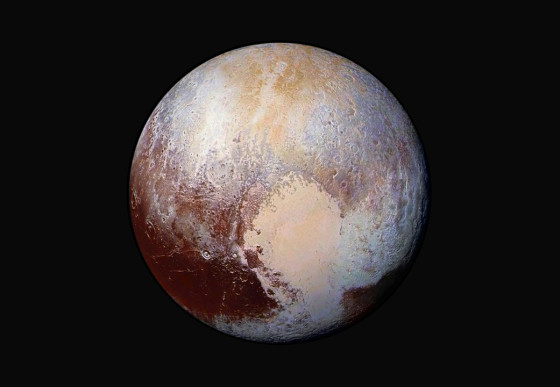Swoon: Pluto in “exaggerated” color is a gorgeous look at the Dwarf Planet
Now that’s a planet, folks! Classification be damned, Pluto is an amazing little world, and this high-res, enhanced-color image is the latest awe-inspiring portrait of it. And it’s revealing all sorts of fascinating details about the dwarf planet’s active surface.
This exquisite new global view of Pluto combines four images taken by New Horizons’ Long Range Reconnaissance Imager (LORRI) from a distance of 280,000 miles (450,000 kilometers), in addition to color data from the Ralph instrument. We can now see bumps and craters as small as 1.4 miles (2.2 kilometers) across on Pluto’s surface.
Exaggerated color images are more than just eye candy. As the New Horizons science team explained in a press conference today, colors are helping to tell the story of the dwarf planet’s very complicated pattern of seasonal ice transport. Pluto has a highly elliptical orbit, which means that compared to Earth it gets both much closer and much farther away from the Sun during its 248 Earth-year rotation. What’s more, Pluto’s north pole is tilted at an angle of 120 degrees relative to its orbital plane. Together, these factors mean that different parts of the surface receive different amounts of sunlight throughout a Pluto year, powering the sublimation of ice into the atmosphere.
According to the New Horizons science team, the deep reddish color we see in Pluto’s southwestern hemisphere is probably due to ice particles filled with dark red hydrocarbons called tholins, which are forming in Pluto’s atmosphere. When this region gets hit with direct sunlight, its reddish ice gets volatilized and transported toward the north pole, where it recondenses onto the surface. This pattern of ice sublimation and deposition is probably why we’re seeing distinct latitudinal color bands.
Of course, the ‘heart’ region now called Tombaugh Regio clearly interrupts this reddish gradient. The science team suspects that the western half (or left lobe) of Pluto’s heart is a major source region for a different kind of ice — but we don’t yet know why. Just another mystery that we’ll continue to unravel as data streams in over the next year and a half — remember, folks, we’ve only downlinked 4 to 5% of the information so far.




